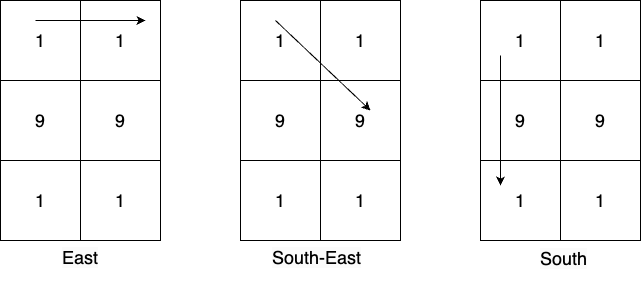Most Frequent Prime
MediumUpdated: Aug 2, 2025
Practice on:
Problem
You are given a m x n 0-indexed 2D**** matrix mat. From every cell, you can create numbers in the following way:
- There could be at most
8paths from the cells namely: east, south-east, south, south-west, west, north-west, north, and north-east. - Select a path from them and append digits in this path to the number being formed by traveling in this direction.
- Note that numbers are generated at every step, for example, if the digits along the path are
1, 9, 1, then there will be three numbers generated along the way:1, 19, 191.
Return _the most frequent prime number greater than _10 out of all the numbers created by traversing the matrix or-1 if no such prime number exists. If there are multiple prime numbers with the highest frequency, then return thelargest among them.
Note: It is invalid to change the direction during the move.
Examples
Example 1
****
Input: mat = [[1,1],[9,9],[1,1]]
Output: 19
Explanation:
From cell (0,0) there are 3 possible directions and the numbers greater than 10 which can be created in those directions are:
East: [11], South-East: [19], South: [19,191].
Numbers greater than 10 created from the cell (0,1) in all possible directions are: [19,191,19,11].
Numbers greater than 10 created from the cell (1,0) in all possible directions are: [99,91,91,91,91].
Numbers greater than 10 created from the cell (1,1) in all possible directions are: [91,91,99,91,91].
Numbers greater than 10 created from the cell (2,0) in all possible directions are: [11,19,191,19].
Numbers greater than 10 created from the cell (2,1) in all possible directions are: [11,19,19,191].
The most frequent prime number among all the created numbers is 19.
Example 2
Input: mat = [[7]]
Output: -1
Explanation: The only number which can be formed is 7. It is a prime number however it is not greater than 10, so return -1.
Example 3
Input: mat = [[9,7,8],[4,6,5],[2,8,6]]
Output: 97
Explanation:
Numbers greater than 10 created from the cell (0,0) in all possible directions are: [97,978,96,966,94,942].
Numbers greater than 10 created from the cell (0,1) in all possible directions are: [78,75,76,768,74,79].
Numbers greater than 10 created from the cell (0,2) in all possible directions are: [85,856,86,862,87,879].
Numbers greater than 10 created from the cell (1,0) in all possible directions are: [46,465,48,42,49,47].
Numbers greater than 10 created from the cell (1,1) in all possible directions are: [65,66,68,62,64,69,67,68].
Numbers greater than 10 created from the cell (1,2) in all possible directions are: [56,58,56,564,57,58].
Numbers greater than 10 created from the cell (2,0) in all possible directions are: [28,286,24,249,26,268].
Numbers greater than 10 created from the cell (2,1) in all possible directions are: [86,82,84,86,867,85].
Numbers greater than 10 created from the cell (2,2) in all possible directions are: [68,682,66,669,65,658].
The most frequent prime number among all the created numbers is 97.
Constraints
m == mat.lengthn == mat[i].length1 <= m, n <= 61 <= mat[i][j] <= 9
Solution
Method 1 - Enumeration + Primality Check
Intuition
We can enumerate all possible numbers formed by moving in each of the 8 directions from every cell, collecting numbers at each step. For each number > 10, check if it is prime and count its frequency. Finally, return the largest prime with the highest frequency.
Approach
- For each cell, for each direction, traverse and build numbers step by step, collecting all numbers > 10.
- For each such number, check if it is prime (using a simple primality test).
- Count the frequency of each prime number.
- Return the largest prime with the highest frequency, or -1 if none.
Code
Java
import java.util.*;
class Solution {
int[][] dirs = {{0,1},{1,1},{1,0},{1,-1},{0,-1},{-1,-1},{-1,0},{-1,1}};
public int mostFrequentPrime(int[][] mat) {
int m = mat.length, n = mat[0].length;
Map<Integer, Integer> freq = new HashMap<>();
for (int i = 0; i < m; i++) {
for (int j = 0; j < n; j++) {
for (int[] d : dirs) {
int x = i, y = j, num = 0;
for (int step = 0; step < Math.max(m, n); step++) {
num = num * 10 + mat[x][y];
if (num > 10 && isPrime(num)) {
freq.put(num, freq.getOrDefault(num, 0) + 1);
}
x = (x + d[0] + m) % m;
y = (y + d[1] + n) % n;
}
}
}
}
int maxFreq = 0, ans = -1;
for (int k : freq.keySet()) {
if (freq.get(k) > maxFreq || (freq.get(k) == maxFreq && k > ans)) {
maxFreq = freq.get(k);
ans = k;
}
}
return ans;
}
boolean isPrime(int x) {
if (x < 2) return false;
for (int i = 2; i * i <= x; i++) {
if (x % i == 0) return false;
}
return true;
}
}
Python
def mostFrequentPrime(mat):
from collections import Counter
m, n = len(mat), len(mat[0])
dirs = [(0,1),(1,1),(1,0),(1,-1),(0,-1),(-1,-1),(-1,0),(-1,1)]
freq = Counter()
def is_prime(x):
if x < 2: return False
for i in range(2, int(x ** 0.5) + 1):
if x % i == 0: return False
return True
for i in range(m):
for j in range(n):
for dx, dy in dirs:
x, y, num = i, j, 0
for step in range(max(m, n)):
num = num * 10 + mat[x][y]
if num > 10 and is_prime(num):
freq[num] += 1
x = (x + dx) % m
y = (y + dy) % n
if not freq:
return -1
max_freq = max(freq.values())
return max([k for k, v in freq.items() if v == max_freq])
Complexity
- ⏰ Time complexity:
O(m * n * d * L)— For each cell, direction, and step, with L = number of digits, d = 8 directions. - 🧺 Space complexity:
O(K)— For frequency map, K = number of distinct primes found.